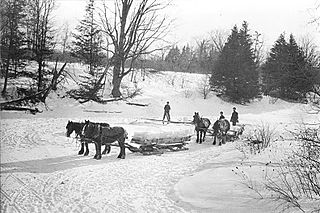
A circular saw is a power-saw using a toothed or abrasive disc or blade to cut different materials using a rotary motion spinning around an arbor. A hole saw and ring saw also use a rotary motion but are different from a circular saw. Circular saws may also be loosely used for the blade itself. Circular saws were invented in the late 18th century and were in common use in sawmills in the United States by the middle of the 19th century.

A chisel is a tool with a characteristically shaped cutting edge of blade on its end, for carving or cutting a hard material such as wood, stone, or metal by hand, struck with a mallet, or mechanical power. The handle and blade of some types of chisel are made of metal or of wood with a sharp edge in it.

The Battle of Stony Point took place on July 16, 1779, during the American Revolutionary War. In a well-planned and -executed nighttime attack, a highly trained select group of George Washington's Continental Army troops under the command of Brigadier General "Mad Anthony" Wayne defeated British troops in a quick and daring assault on their outpost in Stony Point, New York, approximately 30 mi (48 km) north of New York City.

Dalton-le-Dale is a small village in County Durham, in England. The parish population taken at the 2011 census was 1,546. It is situated on the old A19 road between Seaham and Murton. Most of the village is located in a wooded valley bottom, straddling a single road which follows the stream that runs through what is left of Cold Hesledon Dene. Where the road rises to meet the original path of the old A19, there is a small but very fine medieval church which is hidden from the old A19 in a dip. In the opposite direction where the village road to Seaham crosses the stream is Dalden Tower. The pele-tower is the most prominent part of the remains of what was a large medieval manor house complex. The site is a Scheduled Ancient Monument and the tower is Grade II* listed on the National Heritage List for England.

Cold Hesledon is a village in County Durham, in England. It is situated a short distance to the east of Murton.

A butcher knife or butcher's knife is a knife designed and used primarily for the butchering or dressing of animal carcasses.

Yellow Breeches Creek, also known as Callapatscink Creek, Callapatschink Creek or Shawnee Creek is a 56.1-mile-long (90.3 km) tributary of the Susquehanna River in central Pennsylvania, USA. There is no agreed upon explanation for the name Yellow Breeches Creek, which is found in land warrants as early as 1736.

Kirigami is a variation of origami, the Japanese art of folding paper. In kirigami, the paper is cut as well as being folded, resulting in a three-dimensional design that stands away from the page. Kirigami typically does not use glue.

Starveall and Stony Down is a 22.5 hectare biological Site of Special Scientific Interest in the parishes of Codford and Wylye, Wiltshire, England, notified in 1971.

A cold saw is a circular saw designed to cut metal which uses a toothed blade to transfer the heat generated by cutting to the chips created by the saw blade, allowing both the blade and material being cut to remain cool. This is in contrast to an abrasive saw, which abrades the metal and generates a great deal of heat absorbed by the material being cut and saw blade.

An abrasive saw, also known as a cut-off saw or chop saw, is a circular saw which is typically used to cut hard materials, such as metals, tile, and concrete. The cutting action is performed by an abrasive disc, similar to a thin grinding wheel. Technically speaking this is not a saw, as it does not use regularly shaped edges (teeth) for cutting.

Grafting or graftage is a horticultural technique whereby tissues of plants are joined so as to continue their growth together. The upper part of the combined plant is called the scion while the lower part is called the rootstock. The success of this joining requires that the vascular tissues grow together and such joining is called inosculation. The technique is most commonly used in asexual propagation of commercially grown plants for the horticultural and agricultural trades.

Ice cutting is a winter task of collecting surface ice from lakes and rivers for storage in ice houses and use or sale as a cooling method. Rare today, it was common before the era of widespread mechanical refrigeration and air conditioning technology. The work was done as a winter chore by many farmers and as a winter occupation by icemen. Kept insulated, the ice was preserved for cold food storage during warm weather, either on the farm or for delivery to residential and commercial customers with ice boxes. A large ice trade existed in the 19th and early 20th centuries, until mechanical refrigeration displaced it.

In civil engineering, a cut or cutting is where soil or rock from a relative rise along a route is removed. The term is also used in river management to speed a waterway's flow by short-cutting a meander.
Hesledon Moor East is a Site of Special Scientific Interest in the County Durham district in east County Durham, England. It is located on the southern edge of the village of Murton, 10 km south of Sunderland and a little under 2 km north-east of Hesledon Moor West SSSI.
Hesledon Moor West is a Site of Special Scientific Interest in the County Durham district in east County Durham, England. It is located 1 km east of the village of South Hetton, some 12 km south of Sunderland and a little under 2 km south-west of Hesledon Moor East SSSI.
Stony Furlong Railway Cutting is a 2.7-hectare (6.7-acre) geological Site of Special Scientific Interest in Gloucestershire, notified in 1987. The site is listed in the 'Cotswold District' Local Plan 2001-2011 as a Key Wildlife Site (KWS) and a Regionally Important Geological Site (RIGS).














